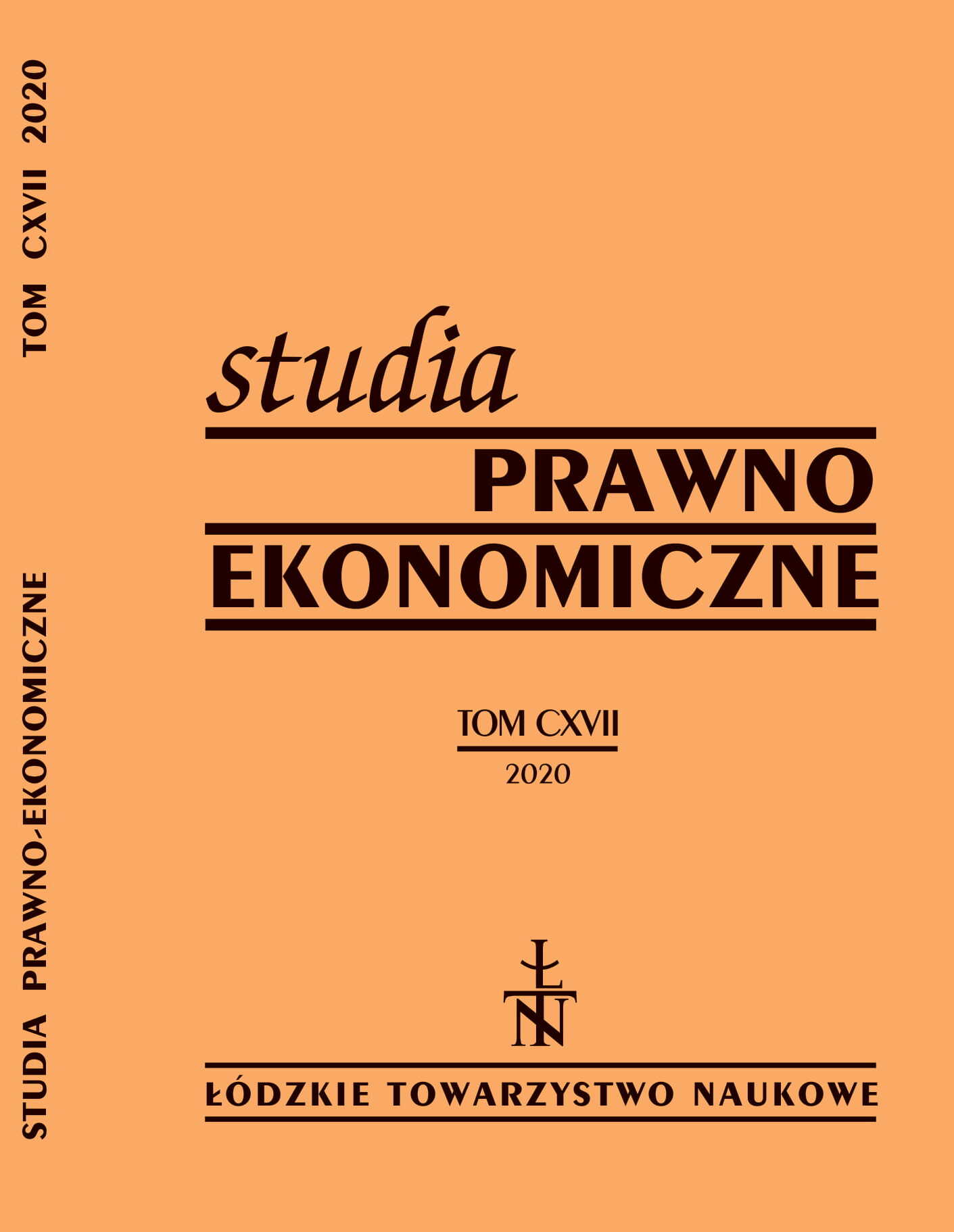The effectiveness of the Federal Reserve System’s monetary policy in the years 1962–2018
DOI:
https://doi.org/10.26485/SPE/2020/117/10Keywords:
monetary policy, interest rates, Federal Reserve SystemAbstract
Background: The monetary policy of the Federal Reserve System affects the term structure of nominal interest rates as well as other asset prices, and thus influences aggregate demand and price levels through these effects. This complex process is known as the monetary transmission mechanism and the transmission process of monetary impulses changes over time. The strength of this impact is a staple subject of economic research.
Research purpose: The aim of the article is to assess the effectiveness of the Federal Reserve System’s monetary policy transmission mechanism over the period 1962–2018. In particular, the scale and timing of the interest rate pass-through to economic activity have been examined.
Methods: Econometric methods (the vector autoregression model) have been used. The empirical analysis was carried out based on U.S. economic statistics for the years 1962–2018, which were taken from the FRED and BEA Databases.
Conclusions: Empirical findings reveal that the way in which the Federal Reserve System’s monetary policy influenced the U.S. economy was diversified at particular time intervals. The results imply that the effectiveness of the U.S. central bank’s interest rate policy has been decreasing since the mid-1980s. Firstly, in the period 1962–1983, the real GDP growth rate and the inflation rate were more sensitive to changes in the federal funds rate than in the period 1984–2018. Secondly, in the period 1962–1983, the effective federal funds rate had an almost threefold greater impact on economic activity and price processes. Thirdly, until the mid-1980s, the effects of monetary impulses were felt longer in the American economy than in the later period. What is more, there is no evidence to suggest that the period of historically low interest rates caused a decline in the effectiveness of the transmission of monetary policy impulses.
References
Belviso F., Milani F., Structural Factor-Augmented VARs (SFAVARs) and the Effects of Monetary Policy, B.E. Journal of Macroeconomics: Topics in Macroeconomics 2006/6 (3), pp. 1–44, https://doi.org/10.2202/1534-5998.1443
Bernanke B.S., Blinder A.S., The Federal Funds Rate and the Channels of Monetary Transmis¬sion, The American Economic Review 1992/82 (4), pp. 901–921.
Bernanke B.S., Mihov I., Measuring Monetary Policy, Quarterly Journal of Economics 1998/113 (3), pp. 869–902, https://doi.org/10.1162/003355398555775
Boivin J., Giannoni M.P., Assessing Changes in the Monetary Transmission Mechanism: A VAR Approach, Federal Reserve Bank of New York Economic Policy Review 2002/8 (1), pp. 97–111.
Boivin J., Giannoni M.P., Has monetary policy become more effective?, The Review of Econom¬ics and Statistics 2006/88 (3), pp. 445–462, https://doi.org/10.1162/rest.88.3.445
Brózda-Wilamek D., Ewolucja strategii polityki pieniężnej FED w latach 1977–2017, Studia Ekonomiczne. Zeszyty Naukowe 2018/352, pp. 22–32.
Brunner A.D., The Federal Funds Rate and the Implementation of Monetary Policy: Estimating the Federal Reserve’s Reaction Function, International Finance Discussion Papers 1994/ (466), pp. 1–46, https://doi.org/10.17016/ifdp.1994.466
Canova F., Gambetti L., Structural changes in the US economy: Is there a role for monetary policy?, Journal of Economic Dynamics and Control 2009/33 (2), pp. 477–490, https://doi. org/10.1016/j.jedc.2008.05.010
Christiano L.J., Eichenbaum M., Trabandt M., Understanding the Great Recession. Ameri¬can Economic Journal: Macroeconomics 2015/7 (1), pp. 110–167, https://doi.org/10.1257/ mac.20140104
Chung H., Laforte J.P., Reifschneider D., Williams J.C., Estimating the macroeconomic ef¬fects of the Fed’s asset purchases, Federal Reserve Bank of San Francisco, Economic Letter 2011/3, pp. 1–5.
Endut N., Morley J., Tien P., The changing transmission mechanism of US monetary policy, Em¬pirical Economics 2018/54 (3), pp. 959–987, https://doi.org/10.1007/s00181-017-1240-7
Höppner F., Melzer C., Neumann T., Changing effects of monetary policy in the US: evidence from a time-varying coefficient VAR, Applied Economics 2008/40 (18), pp. 2353–2360, https://doi.org/10.1080/00036840600970112
Kufel T., Ekonometria. Rozwiązywanie problemów z wykorzystaniem programu GRETL, Wydaw¬nictwo Naukowe PWN, Warszawa 2007.
Kusideł E., Modele wektorowo-autoagresyjne VAR: metodologia i zastosowania, Wydawnictwo Absolwent, Łódź 2000.
Kuttner K.N., Mosser P.C., The Monetary Transmission Mechanism: Some Answers and Further Questions, Federal Reserve Bank of New York Economic Policy Review, May 2002, pp. 15–26.
Leeper E.M., Sims C.A., Zha T., What Does Monetary Policy Do?, Brookings Papers on Eco¬nomic Activity 1996/2, pp. 1–78, https://doi.org/10.2307/2534619
Litterman R.B., Weiss L., Money, Real Interest Rates and Output: A Reinterpretation of Postwar US Data, Econometrica 1985/53 (1), pp. 129–156, https://doi.org/10.2307/1911728
Loayza N., Schmidt-Hebbel K., Monetary Policy Functions and Transmission Mechanisms: An Overview, in: N. Loayza, K. Schmidt-Hebbel, (eds.), Monetary Policy: Rules and Transmis¬sion Mechanisms, Central Bank of Chile, 2002, pp. 1–20.
Łyziak T., Przystupa J., Stanisławska E., Wróbel E., Monetary policy transmission disturbances during the financial crisis. A case of an emerging market economy, Eastern European Economics 2011/49 (5), pp. 75–96, https://doi.org/10.2753/EEE0012-8775490504
Mishkin F.S., The channel of monetary transmission: lessons for monetary policy, National Bu¬reau of Economic Research Cambridge (MA) Working Paper 1996/5464, pp. 1–29, https:// doi.org/10.3386/w5464
Peersman G., The Transmission of Monetary Policy in the Euro Area: Are the Effects Different Across Countries?, Oxford Bulletin of Economics and Statistics 2004/66 (3), pp. 285–308, https://doi.org/10.1111/j.1468-0084.2004.00080.x
Romer C.D., Romer D.H., A New Measure of Monetary Shocks: Derivation and Im¬plications, American Economic Review 2004/94 (4), pp. 1055–1084, https://doi. org/10.1257/0002828042002651
Sims C.A., Macroeconomics and reality, Econometrica 1980/48 (1), pp. 1–48, https://doi. org/10.2307/1912017
Walsh C.E., Monetary policy transmission channels and policy instruments, Working Paper, Uni¬versity of California, Santa Cruz 2014, pp. 1–60.
Willis J., Cao G., Has the U.S. economy become less interest rate sensitive?, Economic Review 2015/100 (2), 5–36.
Wu J.C., Xia F.D., Measuring the Macroeconomic Impact of Monetary Policy at the Zero Lo¬wer Bound, Journal of Money, Credit & Banking 2016/48 (2–3), pp. 253–291, https://doi. org/10.1111/jmcb.1230







